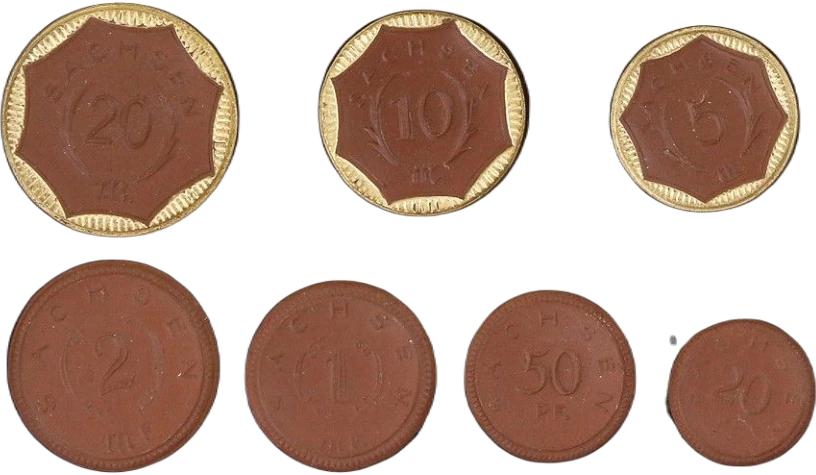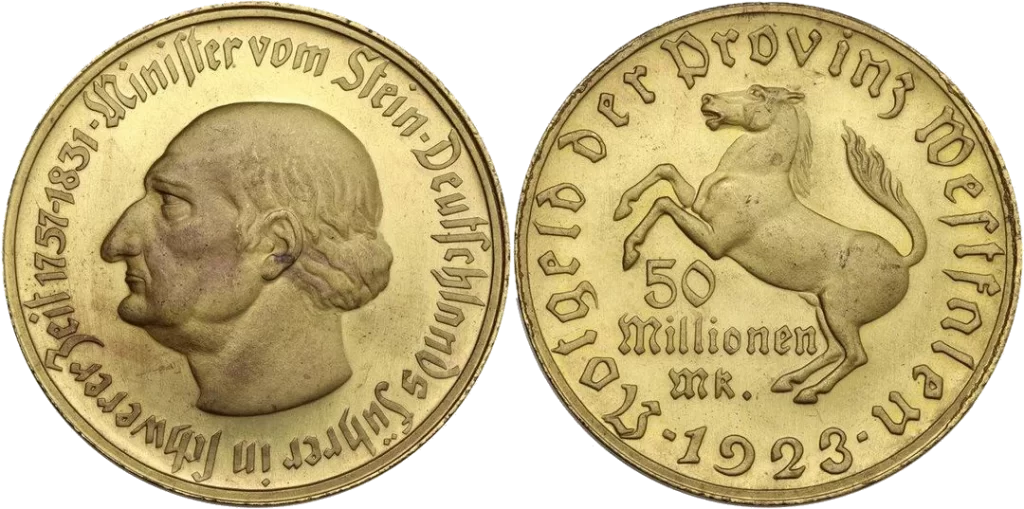If there is something that numismatics and coin collecting have, it is a lot of specialized terminology that is difficult to understand when you are starting out. So, little by little, here in NumisTeacher we will go through their meanings. Today, we will see exactly what Notgeld is: a definition, its history, and some examples.
Notgeld (“emergency money” in English), in its broadest definition, is any banknote and circulating coin produced by smaller public entities than the state (municipality, chamber of commerce…) when the state itself cannot mint them due to a war or an economic or political crisis. In its narrowest definition, Notgeld refers to the coins and banknotes produced by German institutions, generally (but not exclusively) municipalities, between 1914 and 1923.
If you decide to start a notgeld collection, you should know that, in general, both coins and banknotes are easy to find and not too expensive: there are some you can get for a couple of dollars in good condition.
However, there are many of them: it is estimated that there are over 100,000 different notgeld designs, counting both coins and bills. The good thing is that there are also many collectors.
Notgeld Price Guide
There is a good reference catalog and price guide for Notgeld coins: “Die Deutsche Notmünzen”. The only drawback is that it is in German. As far as I know, there is none in English.
You can also find out the value of a notgeld bill through its Pick reference in the general catalog “Standard Guide of World Paper Money”, published by Krause.
A Quick History of German Notgeld
For Germany, the period from the beginning of World War I to the end of the hyperinflation period in 1923 was tremendously unstable. This is reflected not only in the appearance of Notgeld itself but also in its designs and materials.
We can divide the production of Notgeld into three main stages: war, peace, and hyperinflation. Let’s take a look at them:
Stage I: World War I and Verkehrsausgaben (1914-1919)
In 1914, World War I began. From the beginning of the conflict, first in certain areas and then throughout the country, circulating currency began to become scarce. Although in 1914 and 1915 there were only occasional shortages, from 1916, the German Empire was completely unable to guarantee the production of circulating currency.

There were two main reasons for this. The first is that the price of silver had risen so much that the face value of a silver coin at the time was lower than the intrinsic value of the silver with which they were made, so people kept them. The second reason is that the base metals that could be used to mint coins (nickel, copper) were being used for war production.
So, in many cities throughout the country, inhabitants began to mint their own coins and banknotes to try to alleviate the lack of currency. Sometimes they did so with the explicit consent of the German government, sometimes the government turned a blind eye, and sometimes it was directly illegal.

These coins and banknotes are known as Verkehrsausgaben. They were made to be issued into circulation as soon as possible, so they have very crude designs and are made of materials considered unsuitable for circulation, such as iron, zinc, or cardboard.
However, we have to remember that, except for some bombings, there were no battles fought on German territory. People, under the circumstances and the death that surrounded them, continued their normal lives in their homes. And within that normal life, numismatics was a fairly widespread hobby (in fact, it still is today in Germany), so these emergency pieces began to be highly coveted.
When Germany lost the war, its economy was in tatters, and the reparations they had to pay to the victorious countries were the last straw. And of course, German cities and states saw in notgeld a clear opportunity to add more income to their almost empty coffers.
Stage II: Peace and the Serienscheine (1919-1922)
Knowing that there were many collectors and, therefore, it was a fairly lucrative business, many German cities decided to ramp uo their notgeld production.
Designs made by all kinds of artists, even of recognized prestige, were included, illustrating beautiful landscapes, famous buildings, and admirable people, but also satirical or protest scenes.

This type of notgeld is known as Serienscheine, or “series notes.” Many times, the same note or coin was made, but with a small change in the design of one side or on its color, in order to create a cool, collectible series of notes or coins.

The result is that today, these notes and coins are very easy to find in high grades and are not very pricey.
However, although collecting was alive and well, reality always comes knocking at the door. And the economic crisis that Germany began to suffer in the early 1920s became a whirlwind that would eventually affect, of course, notgeld as well.
Stage III: Hyperinflation (1922-1923)
Inflation had been a problem for the Weimar Republic since it was established at the end of the war. But although high, it had always been more or less manageable. That changed at the end of 1921 when the inflationary spiral got out of control. It turns out that, with the economy in shambles and having to pay reparations to the winning countries of the war, Germany printed money. A lot of money. And the more money you print, the less it’s worth.

Of course, what had to happen happened: the situation became unsustainable. In 1914, the German mark was worth a trillion times more than it was in 1923. A loaf of bread in 1922 cost 160 marks. By the end of 1923, 200 billion. People had to do their shopping, literally, with wheelbarrows full of notes.

Once again, the government was unable to produce enough cash to meet the demand for money, despite running the presses at full capacity 24/7. So, in July 1922, they passed a law allowing any public or private entity to legally issue notgeld. That was the final blow, and Germany’s economy collapsed.
Given the circumstances, notgeld returned to those crude, quick, and poorly executed designs, like the ones made during the war. However, the curiosity lies in the face values: there are bills worth up to 50 trillion marks, for example.
The end of notgeld
Hyperinflation came to an abrupt end in November 1923, when the German Central Bank decided to introduce a new currency. The Rentenmark would be backed by gold reserves, effectively returning to the gold standard abandoned before the war, but also by money obtained through loans secured by public properties. It entered circulation in August 1924, and more or less the situation started to get under control.
One of the measures taken in parallel with the introduction of the Rentenmark was the total ban on notgeld and the prosecution of anyone who produced it from that point on. From that moment on, notgeld would be a memory for the Germans and as paper and metal pieces in numismatic and notaphilic albums.